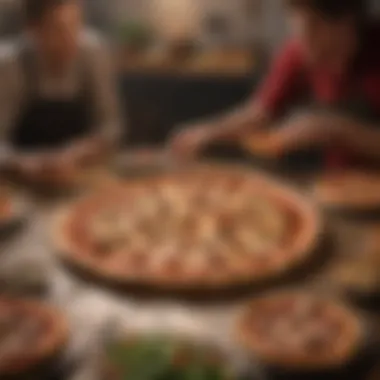Mastering Pizza Orders for Large Groups: A Guide


Intro
Ordering pizza for a large group can be a complex task that requires careful planning and consideration. The enjoyment of a shared pizza experience hinges on not just the flavor, but also on how well the preferences of various guests are catered to. This article will delve into the essential strategies for successfully managing the pizza ordering process, including how to determine the right quantity, selecting options for diverse dietary needs, and optimizing the delivery logistics.
When faced with a diverse group, collecting input regarding food preferences becomes a pivotal first step. Individual tastes vary widely, and accommodating this variablility is key to ensuring satisfaction. Not only does it enhance the overall meal experience, but it also helps prevent the frustration that often accompanies dietary restrictions and flavor mismatches.
It's also crucial to consider logistical factors. How far is the delivery location? What are the peak times for orders? Understanding these elements can prevent potential issues down the line. Through this guide, readers will learn to navigate the intricate landscape of pizza ordering, paving the way for an enjoyable meal that resonates with every guest.
Understanding Group Dynamics
Ordering pizza for a large group involves more than simply choosing toppings. Understanding group dynamics is essential for a satisfactory outcome. This process takes into account various elements, such as preferences, the size of the group, and any dietary restrictions. Getting this step right can significantly enhance everyone’s experience and satisfaction with the meal.
Assessing the Group Size
The first step in understanding group dynamics is to assess the size of your gathering. This task goes beyond counting heads. It involves identifying the exact number of participants and understanding their roles in the event.
Some attendees might have hearty appetites, while others may eat lightly. Ensure that you consider age and activity levels, as these factors can affect how much pizza each person might consume. Generally, a rough estimate is one large pizza for every three to four individuals, depending on the size and toppings of the pizza. This calculation aids in avoiding shortages or excess leftovers that can lead to waste.
"Knowing your group size is the cornerstone of effective pizza ordering."
Identifying Preferences and Dietary Restrictions
Once you have assessed the group size, the next step is identifying preferences and dietary restrictions. People have various tastes in food, and there is a chance that your event will include participants with specific dietary needs. Communicate with your guests ahead of time to collect this information.
Make a list of preferences. Consider the following aspects:
- Toppings: Do people prefer classic toppings like pepperoni and cheese, or are they more inclined towards gourmet options?
- Dietary Restrictions: Note any vegan, vegetarian, or gluten-free requirements.
- Allergies: Are there any allergies to ingredients? This is critical so that orders do not inadvertently put anyone at risk.
Understanding these preferences can greatly enhance the dining experience. It promotes participation and can foster a sense of inclusion among all guests.
Selecting the Right Pizza Vendors
Selecting the right pizza vendors plays a critical role in the success of your large group meal. The vendor you choose can influence not just taste but also selection variety, delivery efficiency, and overall satisfaction. It is essential to evaluate the options available in your area thoroughly. The objective is to find vendors who resonate with your requirements, considering factors such as reputation, menu diversity, and pricing. By doing this, you ensure that everyone in your group finds something they enjoy, which is paramount in a group setting.
Evaluating Local Pizzerias
Evaluating local pizzerias involves understanding their strengths and weaknesses. Start by researching popular options within your region. Look for establishments with a solid track record and positive customer reviews. It can be beneficial to check sites like Yelp or Google Reviews for insights.
Factors to consider include:
- Quality of Ingredients: Fresh and high-quality ingredients lead to better-tasting pizza.
- Reputation for Service: Prompt and courteous service can make or break the ordering experience.
- Variety of Options: A wider selection allows you to cater to diverse preferences, including dietary restrictions.
Conducting tastings is another effective way to evaluate local pizzerias. This can help you determine which pizzerias offer the best flavor profiles and crust styles that your guests might enjoy.
Considering Chain Versus Independent Options
When considering chain versus independent options, weigh the benefits and drawbacks of each. Chain pizzerias often have the advantage of consistent quality and standardized menu items across locations. They may also provide efficient delivery services, which might be crucial when dealing with a large order. However, chains might lack the unique flavors and specialties that independent pizzerias offer.
On the other hand, independent pizza shops frequently pride themselves on their unique recipes and local ingredients. This often results in more innovative and sometimes more appealing flavors. However, service and delivery can be hit or miss.
In summary, consider these aspects:


- Consistency with Chains: Often reliable but less variety in options.
- Creativity with Independents: Unique offerings but potentially inconsistent service.
Choosing the right vendor greatly impacts the overall experience. Gathering input from your group about preferences can also guide your decision to ensure you select a vendor that meets everyone's expectations.
Determining Pizza Variety
When ordering pizza for a large group, determining the variety of pizzas is a crucial step. The selection of flavors and types of pizzas can greatly influence the overall satisfaction of the guests. If the variety does not align with the tastes and preferences of the group, it may lead to disappointment and wasted food. This article segment delves into the essentials of pizza variety and the factors to consider to ensure a successful ordering experience.
Classics versus Innovative Flavors
The choice between classic pizzas and innovative flavors can impact the meal experience. Classic pizzas, such as Margherita, Pepperoni, and Cheese, are typically crowd-pleasers. They appeal to wide audiences because they are familiar and straightforward. These types are less likely to evoke strong negative reactions, making them a safe choice for varying tastes. In contrast, innovative flavors can add excitement to the pizza selection. Options like Thai Chicken or BBQ Veggie may intrigue guests who seek new culinary experiences.
Here are some key points to contemplate when deciding:
- Demographics: Consider the age and preferences of the group. Younger crowds may appreciate bold flavors. Older guests might prefer traditional options.
- Occasion: Formal events may require a more classic selection. Casual gatherings allow for more freedom in exploring diverse flavors.
- Balance: Ensuring a mix prevents monotony. Opt for a few well-known varieties alongside a couple of innovative choices.
"A diverse pizza selection not only pleases the palate but also fuels engaging conversations about flavors and experiences."
Balancing Meat, Veggie, and Specialty Pizzas
Inclusions of meat, veggie, and specialty pizzas create a well-rounded offering that can satisfy most dietary preferences. Meat pizzas tend to be favored by many, offering fillings like sausage, pepperoni, and ham. They are hearty and can be very filling. However, it is essential to balance with veggie options. Many vegetarians and health-conscious individuals appreciate having choices like Spinach and Feta or Veggie Supreme.
Specialty pizzas can introduce flavors that are unique to specific cuisines or regions. They might feature ingredients that prompt guests to explore a new taste. However, it is key to balance these with traditional options. Consider the following:
- Dietary Needs: It is crucial to consider any dietary restrictions among your guests. This can include vegetarian, vegan, or gluten-free requirements.
- Competition: Offering different pizza types reduces competition for a single favorite. This promotes variety and encourages guests to try different things.
- Presentation: A mix of different types can create a visually appealing pizza table that draws attention and excites curiosity.
Calculating Quantity
Calculating the right quantity of pizza is a crucial element when ordering for a large group. Misjudging the number can lead to either a surplus of leftovers or an insufficient supply that leaves guests unsatisfied. It is important to gauge how much to order to ensure everyone enjoys the meal without waste.
Understanding Pizza Sizes and Servings
Pizza typically comes in various sizes, including small, medium, large, and extra-large. Each size offers a different number of slices:
- Small (10 inches): About 6 slices
- Medium (12 inches): About 8 slices
- Large (14 inches): About 10-12 slices
- Extra-Large (16 inches): About 12-16 slices
Knowing the amount each type can serve is essential. The average person consumes approximately 2-4 slices, depending on appetite and other food options available. For example, in a group of 10 people, if each person is estimated to eat 3 slices, one would need to order around 3 large pizzas, as this would yield approximately 30 slices.
Estimating Number of Pizzas Based on Group Size
When estimating the number of pizzas needed, consider these factors:
- The number of guests
- The appitites of the individuals present
- Any other menu items planned
To illustrate, let’s say you are hosting a party with 20 attendees. Assuming most will eat 3 slices:
- Calculate total slices needed: 20 guests x 3 slices = 60 slices.
- Determine slices per pizza based on size, let's use large as an example, offering about 12 slices each.
- Calculate total pizzas: 60 slices ÷ 12 slices per pizza = 5 pizzas plainly needed.
However, it is good practice to account for variety, ensuring there are vegetarian, meat, and perhaps a specialty option, which could adjust the total needed. It is important to round up to ensure everyone is satisfied. As a buffer, ordering one additional pizza is always wise.
By accurately calculating the quantity needed based on these estimations and understanding, you create a better experience for everyone involved.
Exploring Extra Items


When it comes to catering for a large group, pizza alone often does not suffice. Exploring extra items is crucial for ensuring all guests feel satisfied. This section emphasizes the variety of supplementary options, which can elevate the overall dining experience. By thoughtfully selecting appetizers, sides, and beverages, you create a more balanced meal that meets diverse preferences.
Appetizers and Sides
Starting the meal with appetizers can set a welcoming tone. These items serve as a warm-up to the main course and can keep guests occupied while waiting for pizza to arrive. Common choices include garlic knots, chicken wings, or mozzarella sticks. Offering a variety of options is beneficial for accommodating different tastes.
Here are some additional points to consider when selecting appetizers and sides:
- Variety Matters: Include both vegetarian and non-vegetarian options to cater to all palates.
- Portion Control: Choose items that are easy to manage as finger food. This helps maintain cleanliness and creates a relaxed atmosphere.
- Timing: Order appetizers that can be served promptly. Cold items can be prepared earlier and kept in the fridge until needed.
Incorporating thoughtfully chosen appetizers can complement the meal, providing a fuller experience and enhancing guest satisfaction.
Beverages to Complement the Meal
The right beverages can significantly influence your pizza gathering’s overall quality. While soda is a staple, consider offering a mix of options. Non-alcoholic alternatives like sparkling water or iced tea can appeal to varied tastes. Furthermore, if the occasion permits, beer or wine may enrich the meal experience and pair well with the selected pizzas.
When planning your beverage options, keep the following in mind:
- Consider Group Preferences: Get input on drink preferences ahead of time. Not everyone drinks soda.
- Balance the Selection: Provide a mix of drinks such as sugary, caffeine-free, and alcoholic options. This caters to different preferences and dietary restrictions.
- Easy Accessibility: Arrange drinks in a way that guests can help themselves. This also encourages socializing and makes service simpler.
Ultimately, taking the time to include diverse extra items can turn a simple pizza order into a more sophisticated gathering. The right appetizers and beverages contribute to a memorable experience, ensuring that all guests leave satisfied.
Managing the Ordering Process
The management of the ordering process is a crucial step when ordering pizza for a large group. It sets the stage for an organized and enjoyable meal. Proper management ensures that the right quantity and variety are ordered, directly correlating with guest satisfaction. By focusing on structured steps, the chances of miscommunication or unmet expectations decrease significantly. This section delves into two important aspects: gathering input from guests and compiling the final order. Each plays an essential role in achieving a successful pizza experience.
Gathering Input from Guests
Collecting feedback and preferences from guests is vital in this stage. It allows you to tailor the pizza selection to include everyone's tastes. An effective method for gathering input is to use surveys or informal conversations. You might consider making a simple list of potential pizza toppings or styles.
When collecting preferences, consider using the following strategies:
- Use polls or group chats: Platforms like Facebook or dedicated discussion boards on reddit.com may facilitate discussions about favorite toppings.
- Ask about dietary needs: Avoid common pitfalls by inquiring about dietary restrictions or allergies. This will help you in selecting options that are accessible to everyone.
- Balance popular choices with unique options: While classics like pepperoni and cheese are generally safe, adding one or two innovative pizzas may delight adventurous eaters.
Listening to input not only champions inclusivity but also boosts the feeling of community within the group. When guests see their preferences reflected in the final order, it contributes to a more satisfying dining experience.
Compiling and Finalizing the Order
Once you have gathered guest input, the next step is to compile and finalize the order. This stage requires attention to detail to ensure accuracy. Start by reviewing the list of preferences and recommendations, then organize them based on the size of the pizza and the number of guests. It may be helpful to use a simple table format to visualize the order.
- Total Pizza Count: Based on input, calculate the total number of each type of pizza needed.
- Verify Sizes and Amounts: Ensure you have ordered an appropriate mix of small, medium, and large pizzas. This prevents under-ordering of popular varieties.
- Check the Flavor Balance: Aim for diversity by including meat, vegetarian, and specialty pizzas.
You should reconfirm the order with group members before proceeding to finalize. Once complete, you can relay the order to the selected vendor, ensuring all details are correct.
Finalizing the order in a thorough manner can significantly enhance guests' satisfaction, reducing the chances of unmet expectations at meal time.
In summary, managing the ordering process is a vital step in ensuring a successful pizza gathering. By taking the time to gather input and finalize the order meticulously, the rest of the pizza experience will follow suit.
Placing the Order
Placing the order is a pivotal part of the pizza ordering process. This stage determines not only the timeliness of the delivery but also the overall satisfaction of the guests. Effective communication with the vendor enhances the ordering experience. Making sure that all necessary details are crystal clear will minimize any potential for errors.


When it comes to placing the order, timing and clarity are key components. This is where any previous planning and organization come into play.
Choosing the Right Time for Delivery
Selecting the best time for pizza delivery is critical for ensuring that your meal arrives fresh and hot. Consider the schedule of your gathering. If the event starts at 6 PM, aim to set the delivery for around 5:45 PM. This strategic timing gives you a cushion to handle any unexpected hiccups, such as traffic delays or miscommunication with the vendor.
Additionally, evaluate the average delivery times of your chosen pizza vendors. Rush hour might result in longer waits, so planning accordingly can save valuable time. The timing also needs to align with your guests’ activities. If it's a casual gathering, a delivery around key eating times keeps everyone on the same page.
Providing Clear Instructions and Payment Details
Communicating clear instructions is essential while placing the order. Specify delivery details like the address, any special instructions for finding your location, and whether the pizza needs to be delivered to a front desk or a specific room. Miscommunication can lead to misplaced orders or delays.
Moreover, don’t forget to provide accurate payment details. It’s better to confirm the total price, including taxes and tips, before placing the order. Selecting the payment method is also crucial. Whether you opt for online payment or cash upon delivery, ensure that the chosen way is straightforward for both you and the vendor. Double-check all digits and make special mention of any discounts or coupons that you may want to apply.
"Clarity in ordering not only enhances the speed of delivery but also elevates the guest experience."
In summary, the process of placing the order should be thorough and well thought-out. By focusing on timing and communication, you significantly lessen the chance of mistakes. This allows your group to enjoy their pizza without any unwarranted interruptions.
Logistics and Setup for Serving
Effective logistics and setup for serving pizza is crucial to guarantee a smooth experience for your guests. When ordering for a large group, it is not enough to have the right variety and quantity of food. The way you present and facilitate access to the food plays a significant role in ensuring that the meal is enjoyable and stress-free.
The importance of logistics involves several specific elements. Creating designated serving areas can reduce congestion, allowing guests to help themselves without overshadowing one another. In addition, proper organization of eating supplies influences the flow of serving and dining. Focusing methods like pre-arranging plates and utensils can lead to a more pleasant atmosphere, eliminating potential interruptions during the meal.
Designating Serving Areas
Creating a dedicated space for food not only enhances aesthetics but also serves practical purposes. Start by choosing a location that is easily accessible yet away from high-traffic areas to minimize disturbances. Ideally, this should be a flat surface that provides enough room for the pizzas and accompanying items.
Clear pathways should allow your guests to move freely. Mark the serving area clearly using tablecloths or simple signs, eliminating any confusion about where food is located. This aspect alleviates stress from both the hosts and guests, ensuring everyone knows where to find the food.
A well-organized serving area promotes a more enjoyable meal experience by minimizing wait times and maximizing interaction.
Organizing Plates, Napkins, and Utensils
The organization of plates, napkins, and utensils is essential to streamline the serving process. Start by estimating how many guests will be using the serving area, ensuring that there are enough supplies for everyone. This is important to avoid any unnecessary interruptions.
Arrange plates in a visually appealing manner near the pizzas. Stack them in rows or a cascading fashion so that guests can grab one easily. Napkins and utensils should be placed beside the plates—for convenience, using accessible containers works well. It is helpful to set them in an area that anticipates the flow of traffic, preventing bottlenecks.
In addition to regular utensils, consider providing serving utensils for larger pizza slices or side dishes. This helps maintain food hygiene and enables guests to take portions comfortably. Remember to double-check your setup before guests arrive, ensuring everything is in order.
By concentrating on logistics and setup before the gathering, you create an inviting environment that allows guests to enjoy their meal and facilitates a relaxed atmosphere for socializing.
After the Meal Considerations
After enjoying a meal with a large group, it is essential to consider how to handle leftovers and feedback efficiently. This phase can significantly influence the satisfaction of guests and pave the way for future pizza ordering experiences. Managing what remains after the meal not only reduces waste but also shows thoughtfulness toward guests' preferences. Gathering feedback helps refine choices, ensuring you make informed decisions next time.
Managing Leftovers Effectively
Leftover pizza can be a delightful treat when managed correctly. To effectively handle leftovers, consider the following steps:
- Storage Methods: Store leftovers in airtight containers to maintain freshness. Alternatively, wrapping individual slices in foil can also work.
- Reheating Tips: For best results, reheat pizza in an oven or a skillet instead of a microwave. This preserves the crust texture and flavors.
- Sharing is Caring: If certain guests are open to it, offer leftovers to them. This can help reduce waste and may also create a sense of community among friends.
Implementing these methods not only ensures no pizza goes to waste but also leaves guests with good memories tied to your gathering.
Gathering Feedback for Future Orders
Feedback is vital in all aspects of event planning, including pizza ordering. It provides insights into your guests’ preferences and experiences. To collect useful feedback, consider:
- Create a Simple Survey: After the meal, a quick survey can gauge satisfaction levels for items ordered, including favorites and dislikes.
- Encourage Open Conversations: Directly asking guests about their thoughts on the pizza can lead to valuable discussions and insights.
- Track Preferences Over Time: Keeping notes on preferences for future orders will help refine your selections, ensuring you cater even better next time.







